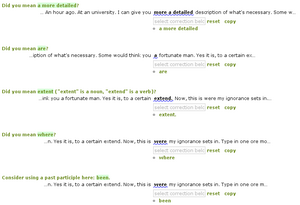Software:LanguageTool
 | |
 LanguageTool WikiCheck | |
| Developer(s) | Daniel Naber and Marcin Miłkowski |
|---|---|
| Initial release | 15 August 2005 |
| Stable release | 5.2 (19 December 2020) [±][1] |
| Written in | Java |
| Platform | Java SE |
| Size | |
| Type | Grammar checker |
| License | GNU LGPL v2.1+ |
LanguageTool is a free and open-source grammar, style, and spell checker, and all its features are available for download.[4] The LanguageTool website connects to a proprietary sister project called LanguageTool Premium (formerly LanguageTool Plus), which provides improved error detection for English and German, as well as easier revision of longer texts, following the open-core model.
It was started by Daniel Naber for his diploma thesis[5] in 2003 (then written in Python). It now supports 31 languages, each developed by volunteer maintainers, usually native speakers of each language.[6] Based on error detection patterns, rules are created and then tested for a given text. The core app itself is free and open-source and can be downloaded for offline use. Some languages use 'n-gram' data,[7] which is massive and requires considerable processing power and I/O speed, for some extra detections. As such, LanguageTool is also offered as a web service that does the processing of 'n-grams' data on the server-side. LanguageTool Premium also uses n-grams as part of its freemium business model.
LanguageTool web service can be used via a web interface in a web browser, or via a specialized client-side plug–ins for Microsoft Office, LibreOffice, Apache OpenOffice, Vim, Emacs, Firefox, Thunderbird, and Google Chrome.
Technology
LanguageTool does not check a sentence for grammatical correctness, but whether it contains typical errors. Therefore, it is easy to invent ungrammatical sentences that LanguageTool will still accept. Error detection succeeds with a variety of rules based on XML or written in Java.[8] XML-based rules can be created using an online form.[9]
More recent developments rely on large n-gram libraries that offer suggestions for improving misspellings with the help of artificial neural networks.[10]
See also
References
- ↑ "LanguageTool Change Log". 19 December 2020. https://github.com/languagetool-org/languagetool/blob/master/languagetool-standalone/CHANGES.md.
- ↑ "Index of /download/". https://languagetool.org/download/.
- ↑ "Index of /download/ngram-data/". https://languagetool.org/download/ngram-data/.
- ↑ "LanguageTool - Spell and Grammar Checker". https://languagetool.org/#libreoffice.
- ↑ Daniel Naber. "A Rule-Based Style and Grammar Checker". http://danielnaber.de/languagetool/download/style_and_grammar_checker.pdf.
- ↑ "Supported languages". 28 December 2016. https://languagetool.org/languages/.
- ↑ "N-Gram Data Download Page". 2019-03-30. https://languagetool.org/download/ngram-data/.
- ↑ "Linux Administration", Pro Oracle Database 10g RAC on Linux (Berkeley, CA: Apress): pp. 385–400, 2006, doi:10.1007/978-1-4302-0214-1_15, ISBN 978-1-59059-524-4, http://dx.doi.org/10.1007/978-1-4302-0214-1_15, retrieved 2022-02-23
- ↑ "Create a new LanguageTool rule". https://community.languagetool.org/ruleEditor2/.
- ↑ SKILL 2018 : Fachwissenschaftlicher Informatik-Kongress, Studierendenkonferenz Informatik, 26.-27. September 2018, Berlin. Gesellschaft für Informatik. [Bonn]. 2018. ISBN 978-3-88579-448-6. OCLC 1066024545. https://www.worldcat.org/oclc/1066024545.
External links
 |

